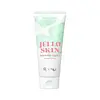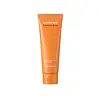What's inside
What's inside
 Key Ingredients
Key Ingredients

 Benefits
Benefits

 Concerns
Concerns

 Ingredients Side-by-side
Ingredients Side-by-side

Water
Skin ConditioningGlycerin
HumectantPropanediol
SolventHydrogenated Poly(C6-14 Olefin)
EmollientNiacinamide
SmoothingPolyglyceryl-6 Distearate
EmulsifyingCetearyl Alcohol
EmollientPropylheptyl Caprylate
EmollientAmmonium Acryloyldimethyltaurate/Vp Copolymer
Candelilla/Jojoba/Rice Bran Polyglyceryl-3 Esters
Emulsifying1,2-Hexanediol
Skin ConditioningVinyldimethicone
Glyceryl Stearate
EmollientMethyl Trimethicone
Skin ConditioningHydroxyacetophenone
AntioxidantDipropylene Glycol
HumectantLaminaria Japonica Extract
Skin ProtectingEclipta Prostrata Leaf Extract
Skin ConditioningCoptis Japonica Root Extract
Skin ConditioningButylene Glycol
HumectantOryza Sativa Bran Oil
EmollientEthylhexylglycerin
Skin ConditioningXanthan Gum
EmulsifyingSodium Stearoyl Glutamate
CleansingFructooligosaccharides
HumectantAdenosine
Skin ConditioningGlyceryl Polymethacrylate
Hydrogenated Lecithin
EmulsifyingBeta-Glucan
Skin ConditioningPanthenol
Skin ConditioningHydrolyzed Hyaluronic Acid
HumectantMaltodextrin
AbsorbentTocopherol
AntioxidantMethylpropanediol
SolventHydrolyzed Gardenia Florida Extract
AntioxidantCeramide NP
Skin ConditioningOpuntia Coccinellifera Fruit Extract
Skin ConditioningPhaseolus Vulgaris Seed Extract
Skin ConditioningWater, Glycerin, Propanediol, Hydrogenated Poly(C6-14 Olefin), Niacinamide, Polyglyceryl-6 Distearate, Cetearyl Alcohol, Propylheptyl Caprylate, Ammonium Acryloyldimethyltaurate/Vp Copolymer, Candelilla/Jojoba/Rice Bran Polyglyceryl-3 Esters, 1,2-Hexanediol, Vinyldimethicone, Glyceryl Stearate, Methyl Trimethicone, Hydroxyacetophenone, Dipropylene Glycol, Laminaria Japonica Extract, Eclipta Prostrata Leaf Extract, Coptis Japonica Root Extract, Butylene Glycol, Oryza Sativa Bran Oil, Ethylhexylglycerin, Xanthan Gum, Sodium Stearoyl Glutamate, Fructooligosaccharides, Adenosine, Glyceryl Polymethacrylate, Hydrogenated Lecithin, Beta-Glucan, Panthenol, Hydrolyzed Hyaluronic Acid, Maltodextrin, Tocopherol, Methylpropanediol, Hydrolyzed Gardenia Florida Extract, Ceramide NP, Opuntia Coccinellifera Fruit Extract, Phaseolus Vulgaris Seed Extract
Water
Skin ConditioningGlycerin
HumectantButylene Glycol
HumectantDimethicone
Emollient1,2-Hexanediol
Skin ConditioningC13-15 Alkane
SolventPolyglyceryl-3 Methylglucose Distearate
EmulsifyingGlyceryl Stearate
EmollientGlyceryl Polymethacrylate
Carbomer
Emulsion StabilisingCetearyl Alcohol
EmollientTromethamine
BufferingAmmonium Acryloyldimethyltaurate/Vp Copolymer
Hydroxyacetophenone
AntioxidantSilica
AbrasiveLimnanthes Alba Seed Oil
Skin ConditioningCucurbita Pepo Fruit Extract
Skin ConditioningEthylhexylglycerin
Skin ConditioningCentella Asiatica Extract
CleansingDisodium EDTA
Portulaca Oleracea Extract
Skin ConditioningChamomilla Recutita Flower Extract
MaskingVitex Agnus-Castus Extract
AstringentArctium Lappa Root Extract
Skin ConditioningPhellinus Linteus Extract
Skin ConditioningHydrolyzed Collagen
EmollientCucurbita Pepo Seed Extract
Skin ConditioningZingiber Officinale Root Extract
MaskingDimethylsilanol Hyaluronate
HumectantHydrolyzed Hyaluronic Acid
HumectantHydrolyzed Sodium Hyaluronate
Skin ConditioningHyaluronic Acid
HumectantPotassium Hyaluronate
Skin ConditioningSodium Hyaluronate
HumectantSodium Hyaluronate Crosspolymer
HumectantHydroxypropyltrimonium Hyaluronate
Sodium Hyaluronate Dimethylsilanol
HumectantSodium Acetylated Hyaluronate
HumectantPhaseolus Radiatus Seed Extract
Skin ConditioningHydrogenated Lecithin
EmulsifyingCaprylic/Capric Triglyceride
MaskingRetinol
Skin ConditioningPolyglyceryl-10 Myristate
Skin ConditioningTocopheryl Acetate
AntioxidantPyrus Communis Fruit Extract
Skin ConditioningRose Extract
Skin ConditioningPrunus Persica Fruit Extract
AbrasiveCucumis Melo Fruit Extract
Skin ConditioningHedera Helix Leaf/Stem Extract
AntimicrobialWater, Glycerin, Butylene Glycol, Dimethicone, 1,2-Hexanediol, C13-15 Alkane, Polyglyceryl-3 Methylglucose Distearate, Glyceryl Stearate, Glyceryl Polymethacrylate, Carbomer, Cetearyl Alcohol, Tromethamine, Ammonium Acryloyldimethyltaurate/Vp Copolymer, Hydroxyacetophenone, Silica, Limnanthes Alba Seed Oil, Cucurbita Pepo Fruit Extract, Ethylhexylglycerin, Centella Asiatica Extract, Disodium EDTA, Portulaca Oleracea Extract, Chamomilla Recutita Flower Extract, Vitex Agnus-Castus Extract, Arctium Lappa Root Extract, Phellinus Linteus Extract, Hydrolyzed Collagen, Cucurbita Pepo Seed Extract, Zingiber Officinale Root Extract, Dimethylsilanol Hyaluronate, Hydrolyzed Hyaluronic Acid, Hydrolyzed Sodium Hyaluronate, Hyaluronic Acid, Potassium Hyaluronate, Sodium Hyaluronate, Sodium Hyaluronate Crosspolymer, Hydroxypropyltrimonium Hyaluronate, Sodium Hyaluronate Dimethylsilanol, Sodium Acetylated Hyaluronate, Phaseolus Radiatus Seed Extract, Hydrogenated Lecithin, Caprylic/Capric Triglyceride, Retinol, Polyglyceryl-10 Myristate, Tocopheryl Acetate, Pyrus Communis Fruit Extract, Rose Extract, Prunus Persica Fruit Extract, Cucumis Melo Fruit Extract, Hedera Helix Leaf/Stem Extract
 Reviews
Reviews

Ingredients Explained
These ingredients are found in both products.
Ingredients higher up in an ingredient list are typically present in a larger amount.
1,2-Hexanediol is a synthetic liquid and another multi-functional powerhouse.
It is a:
- Humectant, drawing moisture into the skin
- Emollient, helping to soften skin
- Solvent, dispersing and stabilizing formulas
- Preservative booster, enhancing the antimicrobial activity of other preservatives
Ammonium Acryloyldimethyltaurate/Vp Copolymer (let's call it AAVC for short) is a synthetically created polymer. It's used as a film-forming agent and used to thicken the consistency of products.
AAVC is able to increase the consistency and viscosity of products due to its large molecule size. It also prevents ingredients from separating.
Butylene Glycol (or BG) is used within cosmetic products for a few different reasons:
Overall, Butylene Glycol is a safe and well-rounded ingredient that works well with other ingredients.
Though this ingredient works well with most skin types, some people with sensitive skin may experience a reaction such as allergic rashes, closed comedones, or itchiness.
Learn more about Butylene GlycolCetearyl alcohol is a mixture of two fatty alcohols: cetyl alcohol and stearyl alcohol. It is mainly used as an emulsifier. Emulsifiers help prevent the separation of oils and products. Due to its composition, it can also be used to thicken a product or help create foam.
Cetearyl alcohol is an emollient. Emollients help soothe and hydrate the skin by trapping moisture.
Studies show Cetearyl alcohol is non-toxic and non-irritating. The FDA allows products labeled "alcohol-free" to have fatty alcohols.
This ingredient is usually derived from plant oils such as palm, vegetable, or coconut oils. There is debate on whether this ingredient will cause acne.
Due to the fatty acid base, this ingredient may not be Malassezia folliculitis safe.
Learn more about Cetearyl AlcoholEthylhexylglycerin (we can't pronounce this either) is commonly used as a preservative and skin softener. It is derived from glyceryl.
You might see Ethylhexylglycerin often paired with other preservatives such as phenoxyethanol. Ethylhexylglycerin has been found to increase the effectiveness of these other preservatives.
Glycerin is already naturally found in your skin. It helps moisturize and protect your skin.
A study from 2016 found glycerin to be more effective as a humectant than AHAs and hyaluronic acid.
As a humectant, it helps the skin stay hydrated by pulling moisture to your skin. The low molecular weight of glycerin allows it to pull moisture into the deeper layers of your skin.
Hydrated skin improves your skin barrier; Your skin barrier helps protect against irritants and bacteria.
Glycerin has also been found to have antimicrobial and antiviral properties. Due to these properties, glycerin is often used in wound and burn treatments.
In cosmetics, glycerin is usually derived from plants such as soybean or palm. However, it can also be sourced from animals, such as tallow or animal fat.
This ingredient is organic, colorless, odorless, and non-toxic.
Glycerin is the name for this ingredient in American English. British English uses Glycerol/Glycerine.
Learn more about GlycerinWe don't have a description for Glyceryl Polymethacrylate yet.
Glyceryl Stearate is a mix of glycerin and stearic acid.
It is used to stabilize the mixing of water and oil ingredients. By preventing these ingredients from separating, it can help elongate shelf life. It can also help thicken the product's texture.
As an emollient, it helps soften skin and supports barrier-replenishing ingredients.
In cosmetics, Glyceryl Stearate is often made from vegetable oils or synthetically produced.
This ingredient may not be fungal-acne safe
Fun fact: The human body also creates Glyceryl Stearate naturally.
Learn more about Glyceryl StearateHydrogenated Lecithin is created from the hydrogenation of lecithin (a group of phospholipids). Hydrogenation is a chemical reaction between hydrogen and another element.
This ingredient is an emollient and emulsifier. As an emollient, it helps soften skin by trapping moisture within. As an emulsifier, it prevents oil and water ingredients from separating.
Hydrolyzed Hyaluronic Acid is a form of hyaluronic acid. It is created by the hydrolysis of hyaluronic acid with a high molecular weight. Once created, Hydrolyzed Hyaluronic Acid has a low molecular weight.
Low molecular weight HA has been shown to hydrate and increase elasticity of the skin. Increasing elasticity is also associated with reduction of wrinkle depth.
One study found topical low molecular weight hyaluronic acid may be considered for the treatment of rosacea in the adult population. However, we always recommend speaking with a professional about your skin concerns.
Hyaluronic acids are a humectant. This means they draw moisture from the air. Hyaluronic acids help moisturize, soothe, and protect the skin.
Read more about other common forms of hyaluronic acid:
Learn more about Hydrolyzed Hyaluronic AcidHydroxyacetophenone is antioxidant with skin conditioning and soothing properties. It also boosts the efficiency of preservatives.
This ingredient is not irritating or sensitizing.
Water. It's the most common cosmetic ingredient of all. You'll usually see it at the top of ingredient lists, meaning that it makes up the largest part of the product.
So why is it so popular? Water most often acts as a solvent - this means that it helps dissolve other ingredients into the formulation.
You'll also recognize water as that liquid we all need to stay alive. If you see this, drink a glass of water. Stay hydrated!
Learn more about Water